Chandra Gupta Maurya
| Author:Laxman Burdak, IFS (R) |
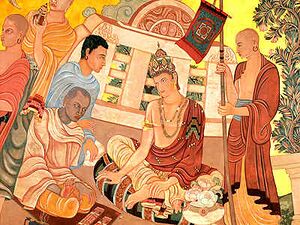
Chandra Gupta (320–298 BCE) (चन्द्रगुप्त) was the founder of Mauryan Empire (320–185 BCE).
Variants
- Sandracotus (Anabasis by Arrian, p. 273, 275.)
- Sandrocottos[1]
- Sandrokotos
- Candragupta
- Androkottos[2]
List of Maurya Kings
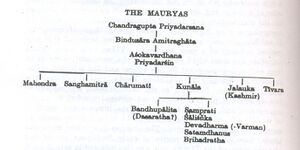
- 320–298 BCE: Chandragupta
- 298–272 BCE: Bindusara
- 268–232 BCE: Ashoka
- 232–224 BCE: Dasharatha
- 224–215 BCE: Samprati
- 215–202 BCE: Shalishuka
- 202–195 BCE: Devavarman
- 195–187 BCE: Shatadhanvan
- 187–185 BCE: Brihadratha
His life
We have little knowledge about the early life of Chandra Gupta, the founder of the Maurya ruling dynasty, which has led to difference of opinion on the issue of his parenthood and early life. Some historians regard him as a prince of the Nanda dynasty while others try to associate him with a poor family. His mother Mura is said to belong to a low caste family. Nevertheless, he held a high rank in Nanda army. Be what it was, the Jaina traditions and Buddhist texts have settled the issue that he was a Kshatriya belonging to a Jat Clan named Maurya.
Mahavansa/Chapter 5 tells that ....The sons of Kalasoka were ten brothers, twenty-two years did they reign in Magadha. Afterwards, the nine Nandas were kings in succession; they too reigned twenty-two years in Magadha. Then did the brahman Canakka (Chanakya) anoint a glorious youth, known by the name Candagutta, as king over all Jambudipa, born of a noble clan, the Moriyas, when, filled with bitter hate, he had slain the ninth (Nanda) Dhanananda.
The rise of Chandragupt Maurya
Buddha Prakash[3] mentions....As Justin writes, “India, after Alexander's death, as if the yoke of servitude had [p.91]: been shaken off from its neck, had put his prefects to death. Sandrocottos (Candragupta) had been the leader who achieved their freedom. When he lay down overcome with fatigue and had fallen into a deep sleep, a lion of enormous size, approaching the slumberer, licked with his tongue the sweat, which oozed profusely from his body, and, when he awoke, quietly took his departure. It was this prodigy which first inspired him with the hope of winning the throne and so, having collected a band of robbers, he instigated the Indians to overthrow the existing government. When he was thereafter preparing to attack Alexander's prefects, a wild elephant of monstrous size approached him and, kneeling submissively like a tame elephant, received him on to its back and fought vigorously in front of the army. Sandrocottos (Candragupta), having thus won the throne, was reigning over India." (M’Crindle, Invasion of India by Alexander the Great, pp. 327-28). According to K. P. Jayaswal these legends are represented in the motifs of a lion before a crescented three-arched hill and an elephant below it found at Takshashila (Journal of the Numismatic Society of India, Vol. XIX, (1957), p. 179). These legends became afloat as a result of the meteoric and miraculous rise of Candragupta in the Panjab.
We have seen above that Poros and Candragupta assumed the leadership of the freedom movement in the Panjab and canalized it towards the conquest of the empire of Magadha on the under-standing that they would divide it equally between them.
Death of Poros: But, after the occupation of Pataliputra and the eradication of Nanda rule, Kautilya encompassed the murder of Poros through the Greek general Eudamus who is probably Dingarāta of the Mudraraksasa who, as this drama suggests, did it through a poison-girl.
On the death of Poros, Candragupta was the undisputed master of the empire of northern India. Poros' son Malayaketu broke away from Candragupta and joined the minister of the former Nanda king, but Kautilya won over that minister leaving him in the lurch. Eventually Malayaketu was captured and presented before Candragupta, but, through the intercession of Kautilya, his ancestral kingdom in the Panjab was restored to him and he returned there with his associates. He also patched up his affairs with Eudamus and, at his instance, went to Iran to assist Eumenes against Antigonus in the battle of Gabiene in 316 B. C. But in that battle he died and his kingdom was annexed to the Maurya empire (Buddha Prakash, Studies in Indian History and Civilization, pp. V I38-141).
[p.92]: It is clear from the above account that the Maurya empire was the creation of the Panjabis. It was they who laid its foundations in the Panjab under the leadership of Poros, Candragupta and Kautilya and then spread it up to Magadha. After that they took a prominent part in its conservation and proved its ardent defenders. This was demonstrated on the occasion of the invasion of Seleucos in 305 B. C.
Sandrocottus of Arrian
Arrian[4] writes.......WHOEVER arranges the position of Asia in such a way that it is divided by the Taurus and the Caucasus from the west wind to the east wind, will find that these two very large divisions are made by the Taurus itself, one of which is inclined towards the south and the south wind, and the other towards the north and the north wind. Southern Asia again may be divided into four parts, of which Eratosthenes and Megasthenes make India the largest. The latter author lived with Sibyrtius1, the viceroy of Arachosia, and says that he frequently visited Sandracotus, king of the Indians2.
1. Cf. Arrian, vi. 27 infra.
2. Probably the Chandragupta of the Sanscrit writers. He conquered from the Macedonians the Punjab and the country as far as the Hindu-Koosh. He reigned about 310 B.C.
James Todd writes: [5] Sandrocottus is mentioned by Arrian to be of this line ; and we can have no hesitation, therefore, in giving him a place in the dynasty of Puru, the second son of Yayati, whence the patronymic used by the race now extinct, as was Yadu, the elder brother of Puru. Hence Sandrocottus, if not a Puru himself, is connected with the chain of which the links are Jarasandha (a hero of the Bharat), Ripunjaya, the twenty-third in descent, when a new race, headed by Sanaka and Sheshnag, about six hundred years before Christ, usurped the seat of the lineal descendants of Puru ; in which line of usurpation is Chandragupta, of the tribe Maurya, the Sandrocottus of Alexander, a branch of this Sheshnag, Takshak, or Snake race, a race which, stripped of its allegory, will afford room for subsequent dissertation. The Prasioi of Arrian would be the stock of Puru; Prayag is claimed in the annals yet existing as the cradle of their race. This is the modern Allahabad ; and the Eranaboas must be the Jumna, and the point of junction with the Ganges, where we must place the capital of the Prasioi. [For Sandrokottos or Chandragupta Maurya see Smith, EHI, 42 ff. He certainly did not belong to the ' Snake Race.' The Erannoboas (Skr. Hiranyavaha, ' gold-bearing ') is the river Son. The Prasioi (Skr. Prachyas, dwellers in the east') had their capital at Pataliputra, the modern Patna (McCrindle, Alexander, 365 f.).]
Clan of Chandra Gupta
Mauryans being Jats, were denigrated by Brahmans and are termed even Shudras to show their contempt. Even historians like Romila Thapar are confused. She says – :“Chandra Gupta belonged to the Moriya tribe, but his caste was low, the family apparently being Vaishyas. The young Mourya and his supporters were inferior in ardent strength to Nand.”
Many historians like Romila Thapar have doubts about the origin and clan of Chandra Gupta Maurya. Some have termed him even belonging to Shudra caste. The above content from Mahavansa/Chapter 5 clearly tells that Chandra Gupta Maurya was born of a noble clan, the Moriyas. Also the Mahavansha writes name as Chanda Gutta which can be simply written as Chanda Jutta or Chandra Jat.
Infact Maurya was not a caste but it was a gotra of Jats which is still found in Jats. Gupta was his title and not the caste. He was a warrior of Jat caste.
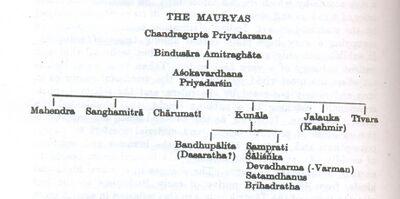
In the list of Jat clans we find:
- Maurya (मौर्य)
- Mor (मोर)
- Mori (मोरी)
- Moriya (मोरिया)
- Morsara (मोरसरा)
- Morwa (मोरवा)
- Morwal (मोरवाल)
- Morya (मोर्या)
All these are Jat gotras of very old standing. Hence the rule of this dynasty has been given a high place in history of Jats.
Mahavamsha describes Chandra Gupta as coming of Kshatriya clan of Maurya: "Mauryanam Khattyanam vamsha jata". (Geiger Trans p 27). It means "Mauryas are Kshatriyas of Jat clan".
There are numerous legends about the Maurya dynasty, as Ashoka of this dynasty was an ardent follower of Buddhism, Brahmin writers have, in the Puranas, called it a Shudra dynasty.
It has, however, been established that Maurya was an old dynasty ruling in the Northern Hills. King Padmananda of the Nanda Dynasty failed in his efforts to conquer this State. Ultimately, his wily minister Shaktar succeeded where Padmananda had failed. As a result of a clever conspiracy the whole ruling family was killed except one pregnant queen who escaped and started living in Magadha as a beggar. One night she delivered a boy and put him in a garbage heap in front of a potter's house. When the potter's wife heard the child's cry, she came out and saw that the boy was handsome as a moon. She took him in her care and named him Gupta Chandra i.e. hidden moon. His mother resolved to rein the Mauryan kingdom one day. She got a job as a maid in the palace so that she could remain in touch with the affairs of the State, She, also kept an eye on her son who displayed signs of greatness.
The Sheshnaga rulers who earlier had their capital at Rajgir, shifted to Patliputra on the confluence of Rivers Ganga and Sone. The ambitions Nanda killed their last ruler and annexed the State. Nanda also conquered the Kaushal kingdom.
At this stage Nanda grew suspicious of his minister Shaktar, son of Viktar. After accusing him of some fictitious offence he got him imprisoned in a dry well.
Chandragupta Empire Expansion
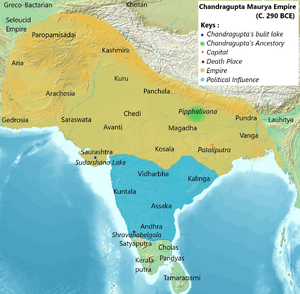
Chandra Gupta conquered Magadha
One day King Nanda happened to laugh. The maid who was attending on him also laughed. The king, considering her action impertinent, sentenced her to death. He however agreed to pardon her if she could tell why he had laughed. At night she went to the dry well and gave food and water to the starving Shaktar. He was grateful and on hearing of her problem, gave her the correct answer. She repeated it to the king the next morning. The king was surprised and asked her how she found the right answer. She told the truth. The king was impressed and ordered Shaktar to be released and reinstated. Shaktar, however, never forgave him and started plotting his destruction.
Vishnu Gupta, well known as Chanakya or Kautilya was educated at the University of Taxila. He was learned but ugly. One day a shoot of spear grass pricked his foot. He said aloud that he would destroy the grass. Shaktar who happened to be passing by told him not to worry, as he would get it destroyed by royal servants. The two became friends after that.
Once Chanakya had gone to a feast given to Brahmins by Nanda on his father's death anniversary. Nanda could not stand Chanakya's ugliness and got him thrown out. Thus Chanakya was harboring a grudge against Nanda. He started looking for some one whom he could train to be capable of destroying Nanda. One day he spotted Chandra Gupta holding a mock-up court of a group of shepherds. He asked him some questions and was impressed by his intelligent answers. Chanakya took Chandra Gupta in his care and trained him so well that with the connivance of Shaktar he became Nanda's C-in-C. He became very popular. Unfortunately the conspiracy leaked out and Chandra Gupta and Chanakya were banished from the country. They migrated to Punjab. At the time of Alexander's invasion they managed to get a number of small states to get together and marshaled a sizeable army under the command of Chandra Gupta. He defeated Alexander's General Seleucus who gave him his daughter Helen in marriage and retired to Greece. Chandra Gupta became the ruler of most of the Punjab with Chanakya as his Prime Minister. Chandra Gupta conquered Magadha thus fulfilling Chanakya's long cherished aim of destroying Nanda.
His Other victories
Conquest of north-west regions
Ancient Greek historian Justin reported that the prefects of Greek territories were assassinated in the Indian uprisings led by Chandragupta Maurya :
- "India, after the death of Alexander, had assassinated his prefects, as if shaking the burden of servitude. The author of this liberation was Sandracottos (Chandragupta Maurya), but he had transformed liberation in servitude after victory, since, after taking the throne, he himself oppressed the very people he has liberated from foreign domination"
-Justin XV.4.12-13 [6]
Megasthenes defined the region that Chandragupta won from Seleucus as likely western side Gedrosia which shares boundaries with the Euphrates River, and eastern side Arachosia shares boundaries with the Indus. The northern frontier boundary formed by Hindukush mountain range:
India, which is in shape quadrilateral, has its eastern as well as its 'western side bounded by the great sea, but on the northern side it is divided by Mount Hemôdos from that part of Skythia which is inhabited by those Skythians who are called the Sakai, while the fourth or western side is bounded by the river called the Indus.
- Book I Fragment I , Indica, Megasthanes [1]
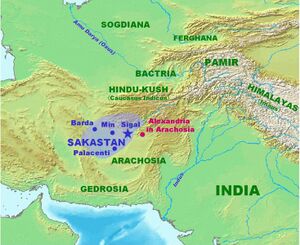
Sandrokottos the king of the Indians, India forms the largest of the four parts into which Southorn Asia is divided, while the smallest part is that region which is included between the Euphrates and our own sea. The two remaining parts, which are separated from the others by the Euphrates and the Indus, and lie between these rivers... India is bounded on its eastern side, right onwards to the south, by the great ocean; that its northern frontier is formed by the Kaukasos range(Hindukush Range) as far as the junction of that range with Tauros; and that the boundary.
- Book I Fragment II , Indica, Megasthanes [2]
The conquest of the south by Chandragupta Maurya may also perhaps be inferred from the following statement of Plutarch. "The throne" in the context is the Magadhan throne, the occupation of which by Chandragupta is thus followed by two other events, viz., the defeat of Selucus, and the conquest of the remaining part of India not included in the Magadhan empire of the Nandas:
"Not long afterwards Androkottos, who had by that time mounted the throne, presented Selukos with 500 elephants, and overran and subdued the whole of India with an army of 600,000."
-Chapter LXII ,Life of Alexander, Plutarch [3]
Greek historians mentioned the result of Seleucid–Mauryan war where Seleucid Empire's eastern satrapies( Gedrosia,Arachosia, Aria, and Paropamisadae) ceded to Mauryan Empire :
Seleucus crossed the Indus and waged war with Sandrocottus [Maurya], king of he Indians, who dwelt on the banks of that stream, until they came to an understanding with each other and contracted a marriage relationship. Some of these exploits were performed before the death of Antigonus and some afterward." — Appian, History of Rome, The Syrian Wars 55
" The geographical position of the tribes is as follows: along the Indus are the Paropamisadae, above whom lies the Paropamisus mountain: then, towards the south, the Arachoti: then next, towards the south, the Gedroseni, with the other tribes that occupy the seaboard; and the Indus lies, latitudinally, alongside all these places; and of these places, in part, some that lie along the Indus are held by Indians, although they formerly belonged to the Persians. Alexander [III 'the Great' of Macedon] took these away from the Arians and established settlements of his own, but Seleucus Nicator gave them to Sandrocottus [Chandragupta], upon terms of intermarriage and of receiving in exchange five hundred elephants. " — Strabo 15.2.9 [4]
Greecian historian Pliny also quoted a passage from Megasthanes work about Chandragupta Empire boundaries:
Most geographers, in fact, do not look upon India as bounded by the river Indus, but add to it the four satrapies of the Gedrose, the Arachotë, the Aria, and the Paropamisadë, the River Cophes thus forming the extreme boundary of India. According to other writers, however, all these territories, are reckoned as belonging to the country of the Aria.
Conquest of the Saurashtra
Chandragupta conquered Southern-Western part of India. Especially his conquest over Saurashtra and Sudarshana lake construction is preseved in later Satrapian king Rudradaman inscription:
(L.8) Transliteration: mauryasya rājyaḥ candra-guptasya rāṣṭriyena vaiśyena puṣpa-guptena kāritam śokasya mauryasya kṛte yavana-raj tuṣāra-saphenādhāyā
—Junagadh rock inscription of Rudradaman[7]
(L.8) for the sake of ordered to be made by the Vaishya Pushyagupta, the provincial governor of the Maurya king Chandragupta; adorned with conduits for Ashoka the Maurya by the Yavana king Tushaspha while governing; and by the conduit ordered to be made by him, constructed in a manner worthy of a king (and) seen in that breach.
In the west, Chandragupta's rule over present-day Gujarat is attested to by Ashoka's inscription in Junagadh. On the same rock, about 400 years later, Rudradaman inscribed a longer text sometime about the mid second–century.
Conquest of the Kuntala
Shikarpur Taluq, inscription 225 . Mentioned about Mauryan ruling in the region of Kuntala .The Kuntala country is an ancient Indian political region included the western Deccan and some parts of central,south Karnataka and north Mysore.
Kuntala-kshôpiyam pesarvett â-nava-Nanda-Gupta-kula-Mauryya-kshmâpar aldar llasaj-jasad [7]
-Shikarpur Taluq, inscription 225
Translation : The Kuntala country, which is like curls (kuntaja) to the lady Earth, was-ruled by the renowned nine Nandas, the Gupta and Mauryan kings. [8]
Treaty of Indus
The ancient Greecian Historians Justin, Appian, and Strabo preserve the three main terms of the Treaty of the Indus:[8]
- (i) Seleucus transferred to Chandragupta's kingdom the easternmost satrapies of his empire, certainly Gandhara, Paropamisadae, and the eastern parts of Gedrosia, Arachosia and Aria as far as Herat.
- (ii) Chandragupta Maurya gave Seleucus 500 Indian war elephants.
- (iii) Epigamia: The two kings were joined by some kind of marriage alliance (ἐπιγαμία οι κῆδος); most likely Chandragupta wed a female relative of Seleucus.
Extent of His Empire
His personal religious belief
If we could place reliance on the statement of Chankya, it is found that in his administrative departments, there existed one post of Devatadhyaksha i.e. Superintendent of Religious Institutions to look after all temples of towns and villages of his realms. He was incharge of temple properties and could set up new Siva-Linga in old temples or set up new temples. [V.2].
If it is true then Chandragupta Maurya placed faith in Siva before his conversion to Jainism as claimed by the Jain Traditions contained in Prisistaparavana.
कुमरार
विजयेन्द्र कुमार माथुर[9] ने लेख किया है ... कुमरार (AS, p.202) पटना (बिहार) के निकट एक ग्राम जो स्टेशन से 8 मील पश्चिम में है. अब यह पटना का ही एक भाग बन गया है. डॉ स्पूनर के मत में चंद्रगुप्त मौर्य (320 ई.) का प्रसिद्ध राजप्रसाद जिसके भव्य सौंदर्य का वर्णन मेगस्थनीज ने किया है-- वर्तमान कुमरार के स्थान पर ही था. इस स्थान से उत्खनन द्वारा इस राजप्रसाद के कुछ अवशेष प्रकाश में लाए गए हैं. देखें पाटलिपुत्र. कुमरार प्राचीन कुसुमपुर का अपभ्रंश जान पड़ता है.
References
- ↑ Buddha Prakash: Evolution of Heroic Tradition in Ancient Panjab, IX. The Contribution to the Maurya and Sunga Empires,p.91
- ↑ Buddha Prakash: Evolution of Heroic Tradition in Ancient Panjab, IX. The Contribution to the Maurya and Sunga Empires,p.92
- ↑ Buddha Prakash:Evolution of Heroic Tradition in Ancient Panjab, IX. The Contribution to the Maurya and Sunga Empires, p.91-92
- ↑ Arrian Anabasis Book/5a, p.275, Chapter vi. General description of India.
- ↑ Annals and Antiquities of Rajasthan, Volume I, Chapter 2 Genealogies continued,p.37
- ↑ "(Transitum deinde in Indiam fecit), quae post mortem Alexandri, ueluti ceruicibus iugo seruitutis excusso, praefectos eius occiderat. Auctor libertatis Sandrocottus fuerat, sed titulum libertatis post uictoriam in seruitutem uerterat ; 14 siquidem occupato regno populum quem ab externa dominatione uindicauerat ipse seruitio premebat." Justin XV.4.12-13
- ↑ "Junagadh Rock Inscription of Rudradaman", Project South Asia.Template:Webarchive
- ↑ Template:Cite book
- ↑ Aitihasik Sthanavali by Vijayendra Kumar Mathur, p.202
Back to The Rulers Back to Jat Kingdoms in Ancient India

